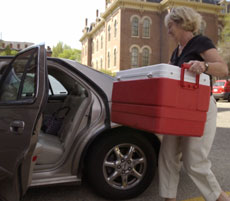Volunteers deliver lunch with smiles

Judy Sehy of Champaign loads her car with meals for the Meals on Wheels program outside of the Illini Union on Tuesday morning. Sehy volunteers as a meal “runner” through her church, St. Matthew´s. John Loos
April 25, 2005
Peggy Heilig is late as usual, but arrives at the Illini Union kitchen with a swell of energy. Dressed in a youthful pink hooded sweater, designer sweat pants, oversized sunglasses and cross-trainers, the athletic, sandy-haired woman, hovering around 60, is ready to move. She examines her route (today it’s the blue route), checks to see if she has the proper amount of meals on her cart, and with a few laughs she’s out the door, ready to deliver them to elderly clients, this time in Savoy, Ill.
“The blue route is a real short route. It’s quick and easy and the people are nice,” says Heilig as she pushes her cart – which holds a cooler filled with cold dinners and a brown rectangular thermal case carrying warm lunches – to her SUV.
The local Meals on Wheels program, a service provided by Family Service of Champaign County, has been around for more than 23 years, providing warm lunches daily to more than 80 residents who have difficulty cooking for themselves. These meals are delivered by a constantly rotating fleet of volunteers, or “runners,” who represent churches, businesses, banks and themselves. And though the situations they see some of their clients living in aren’t always pleasant, the satisfaction of helping feed them almost certainly is.
“I just think it’s very valuable,” says Dot Hunt, a volunteer for 23 years who also sits on a board of four women for Church Women United that contacts church members for volunteering and organizes schedules. “It’s the only place where some of these people get their daily sustenance. It’s wonderful, particularly for individuals who don’t have family.”
For $5.95 a meal, clients receive a hot entr‚e, a vegetable, a side dish, some fruit, bread, a beverage and a dessert that are prepared in the Illini Union kitchen. Cold suppers are also available along with these hot lunches at a combined cost of $8.45 a day. Roughly 30 percent of the clients have specific nutritional needs – such as being diabetic or having low-cholesterol or low-sodium diets – that are taken into consideration when packaging each individual meal.
Get The Daily Illini in your inbox!
The first four stops on Peggy Heilig’s Savoy route are in a working-class neighborhood, and all go smoothly. Heilig, a local realtor, has been running routes for 15 years for her church, Emmanuel Episcopal. The program currently has 47 volunteers ranging in age from 17 to 91.
“I’ve always felt volunteer work is something that, if I have the time and I can do it, I should,” Heilig says. “If you’re capable, you should help people who aren’t.”
“I wanted to do something I thought was a good use of my time,” said Ashley Ferleger, a junior in ALS and a new volunteer who chose to deliver for Meals on Wheels after receiving a list of community service options from an advisor.
The next two stops on Heilig’s route are within the quaint, clean Parkview Senior Apartments. The first client is an impossibly small and frail-looking woman who takes a minute to come to the door, which appears to be quite heavy as she struggles valiantly to open it. The second client’s door must be much lighter, because after an indiscernible shout, a tall man with wild hair flings it wide open. Heilig hands him his meal with the same warm smile she uses for everyone else, and he mumbles a thank you.
While troublesome clients are rare, Heilig reveals that a big reason she dislikes the pink Urbana route is because a male client on it continually insists on answering his door in his underwear.
“He’s perfectly alert. He knows exactly what he’s doing,” she says, adding that he calls her “honey” and once asked if she was married. “I just want to get away as quick as I can. I can’t imagine what a little old church lady on her first run would think.”
These situations are extremely rare, meals on wheels coordinator and Parkland student Kiley McCormack said, and if a problem with a client does arise, it usually involves the person having some form of dementia and being confused as to why they are or are not receiving a meal.
The final stop on the blue route is in an attractive subdivision at a fresh, bright home. A pleasant bald man answers the door and thanks Heilig, and after 45 minutes, her route is done. Pulling out of the neighborhood, she recalls two worst-case scenarios. A few years ago, an elderly woman hadn’t come to the door to receive her meal. A delivery companion riding with Heilig peered in the window and saw the woman on the floor, yelling for help. Another time, a man didn’t come to his door and was later discovered to have had a heart attack and died inside his home.
In the event that a client doesn’t answer their door or it can’t be visually confirmed that a client is home, volunteers are required to immediately call the Meals on Wheels office, which will then call a number or series of numbers on the client’s prearranged emergency contact list.
“Along with giving these people a meal, someone is checking in on them on a daily basis,” says Tami Siddens, the community relations manager at the Family Service Senior Resource Center. “It’s really a multi-purpose service.”
“We’re giving them contact with someone else every day,” says Hunt. “For many of them, we’re the only human contact they have on a given day.”
Driving back to the Union after her successful, smooth run, Heilig pulls onto Green Street and laughs.
“The worst thing about it is the campus traffic,” Heilig said.






